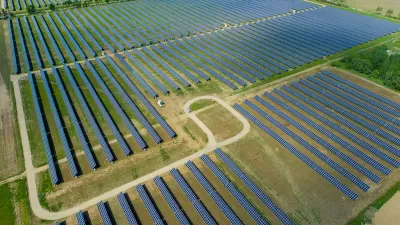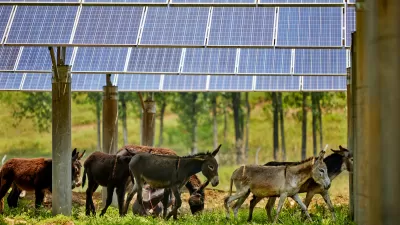Some of the nation's new clean energy capacity is being built on land that formerly grew crops. The sun, quite literally, is worth more than peanuts.
Joe Ryan reports: "Farmland has become fertile territory for clean energy, as solar and wind developers in North America, Europe and Asia seek more flat, treeless expanses to build. That’s also been a boon for struggling U.S. family farms that must contend with floundering commodity prices."
Along those latter lines, cotton process are down 71 percent in the last five years, soybeans 33 percent, and peanuts 16 percent. "Solar companies, meanwhile, are paying top dollar, offering annual rents of $300 to $700 an acre," reports Ryan, using statistics supplied by the NC Sustainable Energy Association.
The article focuses specifically on the new land use paradigms for solar power and farmland in southern states like North Carolina and Georgia. Ryan also discusses the financial and legal arrangements that make the new solar capacity on former farmland possible, along with the local opposition to such plans in many places around the country. One of the most infamous examples of local opposition to a proposal to convert farmland to solar power facility occurred last in 2015 in the North Carolina town of Woodland.
FULL STORY: Harvesting Sunshine More Lucrative Than Crops at Some U.S. Farms

Alabama: Trump Terminates Settlements for Black Communities Harmed By Raw Sewage
Trump deemed the landmark civil rights agreement “illegal DEI and environmental justice policy.”

Planetizen Federal Action Tracker
A weekly monitor of how Trump’s orders and actions are impacting planners and planning in America.

The 120 Year Old Tiny Home Villages That Sheltered San Francisco’s Earthquake Refugees
More than a century ago, San Francisco mobilized to house thousands of residents displaced by the 1906 earthquake. Could their strategy offer a model for the present?

In Both Crashes and Crime, Public Transportation is Far Safer than Driving
Contrary to popular assumptions, public transportation has far lower crash and crime rates than automobile travel. For safer communities, improve and encourage transit travel.

Report: Zoning Reforms Should Complement Nashville’s Ambitious Transit Plan
Without reform, restrictive zoning codes will limit the impact of the city’s planned transit expansion and could exclude some of the residents who depend on transit the most.

Judge Orders Release of Frozen IRA, IIJA Funding
The decision is a victory for environmental groups who charged that freezing funds for critical infrastructure and disaster response programs caused “real and irreparable harm” to communities.
Urban Design for Planners 1: Software Tools
This six-course series explores essential urban design concepts using open source software and equips planners with the tools they need to participate fully in the urban design process.
Planning for Universal Design
Learn the tools for implementing Universal Design in planning regulations.
Clanton & Associates, Inc.
Jessamine County Fiscal Court
Institute for Housing and Urban Development Studies (IHS)
City of Grandview
Harvard GSD Executive Education
Toledo-Lucas County Plan Commissions
Salt Lake City
NYU Wagner Graduate School of Public Service





























